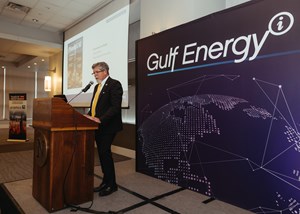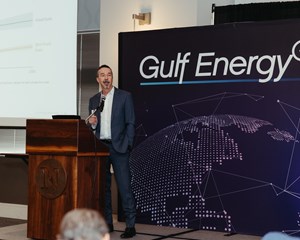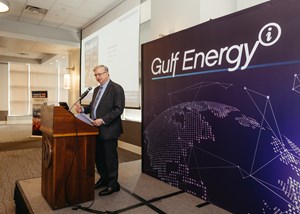World Oil Forecast: Upstream industry to grow moderately in 2024
HOUSTON (WO) – On Friday, Jan. 26, 2024, World Oil hosted its 56th annual Forecast Breakfast at the Norris Conference Center in Houston, Texas. In an event described as a “first look” at upcoming upstream oil and gas trends, approximately 340 professionals from across the sector gathered for an early-morning meal to hear projections, data and analysis on global E&P from industry experts.
Four speakers gave their predictions on oil and gas prices, the offshore market, regulatory policies and drilling activity for 2024. The speakers included Ken Madlock III, Ph.D, Fellow in Energy and Resource Economics at the Baker Institute and Senior Director at the Center for Energy Studies; Bernie Wolford, President and CEO of Diamond Offshore; the Honorable Jim Wright, Commissioner of the Railroad Commission of Texas; and Kurt Abraham, Editor-in-Chief and Chief Forecaster of World Oil.
One point was made clear across all presentations: regardless of “net zero” ambitions, countries large and small will continue to rely on the security that oil and gas provides.

Ken Madlock II, Ph.D: Perspective is everything. The event began with an informative presentation from the Baker Institute’s Ken Madlock, who pointed out that “the world is shaped by where you sit.” When it comes to forecasting, perspective is everything. While developed nations make plans to phase out fossil fuels, the developing world needs them more than ever. In fact, energy demand is rising in up-and-coming nations, whose industrialization is just beginning, Madlock said.
Oil and gas industry foes will have you believe that the sector is declining. However, the global market has grown by 20 MMbopd since 2000. This is not “a story of decline,” as Madlock put it. Successes in innovation, such as the U.S. shale revolution, further support this storyline. Additionally, agencies like the IEA and EIA continue to “push back the goal post” for peak oil demand as populations grow and developing countries catch up with the Western world.
Madlock forecasts that technological innovations in U.S. shale basins and economic growth in Asia will be the primary factors influencing global demand. Although forecasting isn’t an exact science, as Madlock humbly highlighted, there will always be an emphasis on supply, so long as the demand exists, which the Baker Institute fellow sees continuously increasing for the foreseeable future.
Bernie Wolford: Global energy is poised for a multi-year up-cycle. Following Madlock’s presentation was Diamond Offshore President and CEO Bernie Wolford, who echoed many sentiments of Medlock. Despite reports from biased agencies, fossil fuel demand is rising with the global population, which grows by 75 million people annually. To put this number into perspective, that would be equivalent to adding the entire population of England or Germany every year!
While the industry is always changing, Wolford predicts that the sector will shift its focus to exploration, as mature fields in the North Sea go off-line. As such, there will be less investment on jackup rigs in the harsh environment space, specifically offshore the UK and Norway. That said, Wolford sees demand for jackup rigs increasing, driven by developments in the Middle East and Africa.
Wolford’s predictions come from observing customer behavior. Day rates for floaters and jackup rigs are rising, along with orders for subsea trees in line with more FIDs, supporting his theory that offshore drilling will see an uptick in activity during 2024. Additionally, contract lead times and durations are getting longer, further confirming this up-cycle.

Jim Wright: Tackling challenges is essential to industry growth. Texas Railroad Commissioner Jim Wright was third on the docket, beginning his presentation by paying homage to the incredible innovations the oil and gas industry has developed in the last quarter-century. The native Texan proudly reported that his state’s contributions to the industry make the U.S. a powerful player in the market; as he phrased it, “if the U.S. is the master of its own destiny, Texas is the captain of the ship.”
While there’s much to celebrate, Wright acknowledged that the political climate is presenting many challenges. The current administration, Wright said, is creating regulatory uncertainty, which holds the U.S. back from capitalizing on opportunities. Biden’s latest plan to halt LNG export license reviews is a perfect example of this uncertainty. The ban, Wright asserts, comes as a detriment to global energy security. This is especially true of Europe, who has been relying on U.S. imports in recent years in lieu of Russian gas.
Wright also made references to his commission’s recycled produced water framework. The commissioner emphasized that finding alternative uses for produced water is more beneficial than diminishing upstream operations. Limiting water injection, due to seismic activity, isn’t economically or ergonomically feasible. Wright encouraged the audience, filled with operators, drilling contractors and service providers, to use the framework to spur innovation, just as the oil and gas industry has done in the past.
Kurt Abraham: Upstream activity to grow moderately in 2024. Rounding out the event was World Oil’s Editor-in-Chief/ Chief Forecaster Kurt Abraham, who delivered projections and data for upstream activity in 2024. According to the forecast, as many states will be down as up, bringing total growth for U.S. wells to a mere 0.6%.
Notable among U.S. gains will be increases in the Gulf of Mexico, which will see the highest number of wells since 2015, and along the West Coast (CA, OR, AK), where activity will increase by nearly 20%. Growth in these regions is attributed to the development of Shell Offshore’s Sparta project in the Gulf of Mexico and ConocoPhillips’ Willow project in Alaska.
Outside of the U.S., North American activity will drop 2.8%, as Canadian provincial governments in Alberta and Saskatchewan fight against industry-hindering policies from Ottawa. In Mexico, the focus will center around developing Talos’ Zama project and Woodside Energy’s Trion field, both located offshore.
World Oil forecasts that South American drilling will increase just over 3%, led by operations in Brazil, Guyana, Argentina, and, surprisingly, Venezuela.
In Western Europe, drilling is expected to increase 7.6% on the heels of new licensing policies in the UK and increased exploration in Norway. In Eastern Europe, activity is anticipated to fall by 2.8% amidst sanctions and OPEC+ commitments.
African drilling operations will grow by 5.1%, and notably in Namibia, where the prolific Orange basin has yielded multiple commercially viable discoveries. The Middle East will also experience growth, led by activities in Saudi Arabia, Abu Dabi, Kuwait and Qatar.
In the Far East/ South Asia, China will contribute the most to regional growth. However, Malaysia will also be a key player in 2024, as the country makes plans to develop it’s whopping 22 discoveries made last year.
Finally, the South Pacific region will experience a 6.8% increase in activity, thanks to an uptick in drilling from Australia’s Queensland state and an upcoming FID in Papua New Guinea.
Final thoughts. The upstream sector can expect moderate growth, despite predictions of an “oil demand peak” by fear-mongering federal agencies. As long as populations grow, and developing countries tap into their vast resources, oil and gas will play a significant role in the world’s energy security.
For those who could not attend the live presentation in Houston, World Oil will host a webcast covering the forecast on Feb. 15, 2024. As always, a full breakdown of this year’s forecast will be featured in World Oil’s upcoming February issue.




